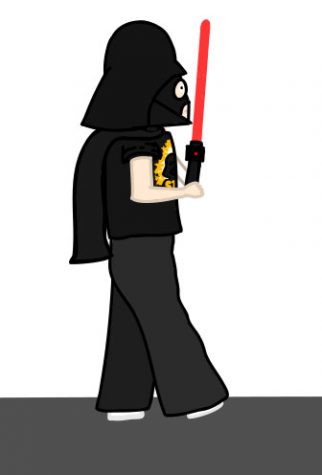The 27 Club glorifies premature death in the music industry
December 3, 2021
Jim Morrison, the charismatic lead singer and songwriter for the ‘60s rock band The Doors, was a detached, extremely intelligent loner as a kid who would spend his time agitating reserved peers and devouring philosophical literature by writers like Nietzsche and Jack Kerouac. He possibly modeled his life after Francis Martin, an enigmatic boy from Kerouac’s debut novel “The Town and City,” who was proclaimed “strange” by his family members and, like Morrison, evaded military life. A creative soul, Morrison collected over 1,000 books in his basement bedroom and covered his walls with a myriad of his own oil paintings and collages. He also enjoyed visiting local art house cinemas and, drawn by the relatively new art of film, later graduated from the University of California, Los Angeles film school. During his time there, Morrison even directed two films, titled “First Love” and “Obscura.” It was only after all these creative endeavors that he actually decided to partake in a musical career and co-founded The Doors in 1965.
After the success of songs like “Break on Through (To the Other Side)” and “Light My Fire,” Morrison joined fellow rock ‘n roll stars in living a tumultuous, unregulated life riddled with drugs, alcohol and parties. Once he noticed the negative health repercussions of this lifestyle, he left the band in 1971 and followed Martin’s footsteps, moving to Paris in hopes of writing poetry and leaving his reckless lifestyle behind. Instead, Morrison was found dead later that year in his Paris apartment from heart failure likely caused by heroin overdose at the young age of 27. Joining Brian Jones, Janis Joplin and Jimi Hendrix, Morrison became part of the infamous group of rock ‘n roll musicians who died at the same age—the 27 Club.
Disregarding theories of the involvement of the planet Saturn or satanic soul-selling in these musicians’ premature deaths, two questions persist: is there any truth supporting the significance of the age 27 among musicians, and what does the 27 Club’s pernicious allure mean for society?
The rock-affiliated 27 Club is a highly selective group to enter. In order to become a member, one would have to tragically die at the age of 27 and have a successful music career before or posthumously. This group, founded upon tragic coincidence, first came to public attention after the death of Morrison. He was the fourth well-known musician to die of unnatural circumstances between 1969 and 1971, following the aforementioned Jones, Joplin and Hendrix and increased the interest in the similarity of their ages at death from almost identical causes of drugs and alcohol. It helped propel his cult fame and reinforce the idea that his death was foreseen by his early on-set success. The myth of the 27 Club intensified when Nirvana’s lead vocalist Kurt Cobain’s mother commented, “Now he’s gone and joined that stupid club. I told him not to…” after he died by suicide in April 1994 at 27. It was further reinforced when British R&B singer Amy Winehouse joined the club in 2011. Disregarding theories of the involvement of the planet Saturn or satanic soul-selling in these musicians’ premature deaths, two questions persist: is there any truth supporting the significance of the age 27 among musicians, and what does the 27 Club’s pernicious allure mean for society?
Music is a defining part of culture in the U.S., which builds off of itself from one generation to the next. As it evolves, societal norms in dress, lifestyle and interests change, but the mystery around the 27 Club has remained omnipresent throughout the years, with blues musician Robert Johnson as its first music-affiliated inductee in 1938 and Winehouse as its most recent one in 2011. The group’s name was first decided upon only after Cobain’s death and, since then, more semi-prominent and popular musicians from the past century have been tacked on to it. Winehouse renewed interest in the “cursed” age of 27 for the current day, causing more to speculate on that particular age’s magnitude on an artist’s success and legacy.
Although the number of famous musicians who died at 27 appears alarming, it is not particularly significant among the musical community. In 2011, the British Medical Journal (BMJ) published a study investigating whether or not 27 was a dangerous age for famous musicians. The study defined famous musicians as “those who had a number one album in the UK charts” during their lifetime. From 1956 to 2007, they found out of the 1046 crooners, death metal stars and rock ‘n rollers included in the study, only three out of the 522 at-risk musicians died at the age of 27, representing just 0.57% of the participants. Ages 25 and 32 had rates of 0.56% and 0.54%, respectively, and the number of at-risk persons only noticeably increased after the age of 60. The study also concluded, though, that the chance of a famous musician dying during their 20s and 30s was two to three times higher than that of the average UK population, deeming the disparity as likely caused by the vastly different lifestyles of famous musicians in comparison to the general public.
In addition to the BMJ study, Dianna Theadora Kenny, former professor of psychology at the University of Sydney, concluded in another analysis that the age of 56 had the highest frequency of deaths for musicians (2.3%) and that, again, 27 was no special number (1.3% of deaths). The notion of the 27 Club may just be another speculation sprouted from the occurrence of fascinating historical coincidences, but the effect it’s had on the music industry and the posthumous success of its members has forever immortalized their legacies and glorified the use of injurious substances among youth.
Pop culture often defines the way teens act, whether that be through television, movies, literature or music. It can also influence their worldview and personal choices, as teens may see their idol’s lifestyle and actions to be something to imitate in order to become more like them. When presented with figures in the 27 Club, younger people may form unhealthy habits, including drug and alcohol use, when trying to act like their idols. The genre of psychedelic rock, or rock music inspired by “mind-expanding” hallucinogens like marijuana and LSD, for example, was popular in the late 1960s and launched the hippie movement in the West Coast with bands forming around it like the Grateful Dead, whose co-founder Ron “Pigpen” McKernan actually became part of the 27 Club.
The stories of Winehouse and Cobain are not those boasting of achievement, but rather dark examples of how trauma, addiction and mental illness can cause even the greatest of artists to succumb to the strain of maintaining an ongoing, appealing public image. Further, pain is not needed for success in the music industry and is often the consequence, not source, of early accomplishments for troubled musicians.
When comparing the periods of prevalence for each member of the 27 Club to alcohol and drug use levels among teens during the same time, substance abuse paralleled the artists’ popularity. In the 70s, bands such as Led Zeppelin—whose drummer John “Bonzo” Bonham died in 1980 after taking 40 shots of 40% ABV vodka—and The Rolling Stones were popular; around 70% of 12th graders in 1976 reported to have used alcohol in the past month while only 33.2% claimed to have done so in 2017. The average age of first use for heroin addicts in the ‘60s was 16 years old during the time of the psychedelic rock group The Grateful Dead as compared to 24 years old in 2010. This simply quantifies how much influence a famous person’s habits can have on a young person, exemplifying the need for musicians to make sure they are setting a good example for their fans and to show that success can come from sobriety too.
The 27 Club, in essence, symbolizes the fragility of a musical prodigy’s life when placed directly under the limelight. The stories of Winehouse and Cobain are not those boasting of achievement, but rather dark examples of how trauma, addiction and mental illness can cause even the greatest of artists to succumb to the strain of maintaining an ongoing, appealing public image. Further, pain is not needed for success in the music industry and is often the consequence, not source, of early accomplishments for troubled musicians. When examining the careers of the stars of the 27 Club, one should resist seeing them as thrilling spectacles full of adventure and fame, but rather lives grievously cut off by unfortunate events, leaving future hits unheard, poems unread and decisions unmade. The world is instead robbed of the impending masterpieces of these musicians, replacing them with the dubious honor of becoming a new member of the 27 Club.
How has rock ‘n roll music changed throughout the years? Let us know in the comments below.




























































































